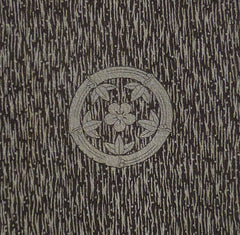A Length of 19th Century Silk: Edo Komon, Kamon and Shochikubai
mid to late 19th century
44" x 14 3/4", 111.75 cm x 37.5 cm
This is a length of katazome dyed chirimen or crepe silk that is dyed with an all-over, small-figure pattern called Edo komon, a type of design that was popular in Japan in the 19th century.
It also shows a resisted family crest that is a combination of plum and bamboo. The interesting metaphor embedded in this length of cloth is that the crest shows bamboo and plum while the all over pattern is that of pine needles, thus combining to form the famous Japanese design pairing called shochikubai: shochikubai is a classic, auspicious pattern. The plum is the first bloom to burst forth from the winter's ice and is symbol of strength, the bamboo bends but does not break so it is a symbol of resilience, and the pine, of course conveys a wish for longevity. Also, pine needles fall in pairs, and thus they are a motif often used at weddings.
A lovely, surprisingly interesting length of old Japanese silk.

